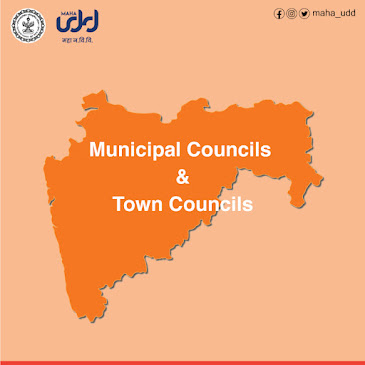शहरी गरिबी / दारिद्र्य निर्मूलनासाठी राज्यामध्ये केंद्र पुरस्कृत सुवर्ण जयंती शहरी रोजगार योजनेची अंमलबजवणी करण्यात येत होती. केंद्रशासनाने सदर योजनेचे वर्ष २०१३-१४ मध्ये रुपांतरीत करून राष्ट्रीय नागरी उपजीविका अभियानाची सुरुवात केली. राज्यामध्ये दि. २८ ऑगष्ट २०१४ च्या शासन निर्णयानुसार राष्ट्रीय नागरी उपजीविका अभियान (५३ शहरे) व राज्य नागरी उपजीविका अभियान (२०६ शहरे) अंमलबजावणीस सुरुवात करण्यात करण्यात आली. दि. १२ मे २०१७ च्या शासन निर्णयानुसार सध्या राज्यातील २५९ शहरांमध्ये (२८ महानगरपालिका व २३१ नगरपरिषद) दीनदयाळ अंत्योदय योजना - राष्ट्रीय नागरी उपजीविका अभियान राबविण्यात येत आहे.
अभियानाची मुख्य उद्दिष्टे काय ?
- नागरी गरीब लोक, त्यांच्या संस्थांची क्षमता बांधणी करणे, उपजीविकेचा विकास व नागरी दारिद्र निर्मुलन करणारी यंत्रणा यांची क्षमता वाढविणे,
- नागरी गरीब कुंटुंबातील व्यक्तींना उपजविकेच्या जास्तीत जास्त संधी उपलब्ध करून देणे,
- बाजाराच्या औद्योगिक गरजेनुसार व आवश्यकतेनुसार, विविध क्षेत्रांच्या गरजा लक्षात घेउन नागरी गरीब व्यक्तींना कौशल्य विकासाचे प्रशिक्षण देउन त्यांना रोजगार व स्वयंरोजगाराची संधी उपलब्ध करून देणे.
- नागरी गरीबांच्या लघुउद्योगांना चालना देणे.
- नागरी बेघर लोकांसाठी कायमस्वरूपी व मूलभूत सोयी सुविधा असलेल्या निवाऱ्याची सोय करणे.
- नागरी फेरीवाल्यांच्या उपजविकेच्या समस्या सोडून त्यांचा दर्जा उंचावण्यासाठी आवश्यक उपाययोजना करणे.
राष्ट्रीय नागरी उपजीविका अभियानाचे घटक :
- सामाजिक अभिसरण व संस्थात्मक विकास/ Social mobilisation and Institution Development (SMID)
- कौशल्य प्रशिक्षणाद्वारे रोजगाराची उपलब्धता/Employment through Skill Training and Placement (EST&P)
- वित्तीय समावेशन व लघुव्यवसाय/Financial Inclusion and Micro Enterprises (FIME)
- नागरी फेरीवाल्यांना सहाय्य / Support to Urban Street Vendor (SUSV)
- नागरी बेघरांना निवारा / Shelter for Urban Homeless (SUH)
- क्षमता बांधणी आणि प्रशिक्षणे / Capacity Building and Training (CBT)
लाभार्थ्यांची निवड कशा प्रकारे होते?
अभियानांतर्गत लाभार्थी निवड ही सामाजिक आर्थिक जातनिहाय सर्वेक्षण २०११ च्या यादीमधील उत्पन्न स्रोतानुसार करण्यात येते. यामधील ० ते ७ उत्पन्नस्रोत असलेल्या व्यक्ती अभियानांतर्गत लाभ घेऊ शकतात. सदर लाभार्थ्यांचे प्रमाण हे ७५% असते तर उर्वरित २५% लाभार्थी हे SC,ST व इतर असतात.
घटक क्र. १ : सामाजिक अभिसरण व संस्थात्मक विकास / Social Mobilisation & Institution Development
“स्वयंसहाय्यता बचतगट” व त्यांच्या संघांचे प्रशिक्षणाच्या माध्यमातून क्षमतावृद्धी करणे, लाभार्थ्यांचे जीवनमान सुधारणे, पतव्यवस्थेचे सुयोग्य व्यवस्थापन करणे, व्यवस्थापकीय व कौशल्य विषयक विविध प्रशिक्षण देऊन लाभार्थ्यांचा सामाजीक सहभाग वाढविण्याच्या दृष्टीने या घटकाची अंमलबजावणी करण्यात आलेली आहे. या घटकातील महत्वाचे उपक्रम ,
- शहरी गरीब लाभार्थ्यांचे स्वयंसहाय्यता बचतगट बनविण्यात येतात,
- स्वयंसहाय्यता गटांमधून वस्ती स्तरीय संघ तयार केले जातात.
- वस्ती स्तरीय संघांमधून शहर स्तरावर शहर स्तरीय संघ तयार केले जातात.
- स्वयंसहाय्यता गटांना तीन महिने पूर्ण झाल्यावर प्रतवारी करून रु. १००००/- फिरते भांडवल उपलब्ध करून देण्यात येते,
- स्वयंसहाय्यता गटांना सहा महिने पूर्ण झाल्यावर प्रतवारी करून बँकेकडून उद्योग व्यवसायासाठी कर्ज उपलब्ध करून देण्यात येते,
- वस्ती स्तरीय संघांना सहा महिने पूर्ण झाल्यावर प्रतवारी करून रु. ५००००/- फिरते भांडवल उपलब्ध करून देण्यात येते,
- सर्व सदस्यांच्या सक्षमिकरणासाठी तसेच संस्था सक्षमीकरणासाठी विविध प्रशिक्षणे आयोजित केली जातात,
- इतर शासकीय योजनांचा लाभ उपलब्ध करून देण्यासाठी मदत केली जाते.
- शहर उपजीविका केंद्राच्या तसेच शहर स्तरीय संघाच्या माध्यमातून उद्योग व्यवसाय करण्यासाठी सहाय्य केले जाते. अभियानाच्या माध्यमातून निर्माण झालेल्या सेवा व उत्पादीत मालाला बाजारपेठ मिळवून देण्यासाठी तसेच रोजगार मिळवून देण्यासाठी अभियानांतर्गत शहरी उपवजविका केंद्राची उभारणी करण्यात येते. अभियानाच्या अंमलबजावणी करीता प्रत्येक शहर उपजीविका केंद्रास रूपये १० लाख इतका अनावर्ती निधी तीन हफ्त्यांमध्ये देण्यात येतो.
घटक क्र. २ : वित्तीय समावेशन व लघुव्यवसाय / FINANCIAL INCLUSION AND MICRO ENTERPRICES
शहरी गरीब, स्वयंसहाय्यता बचतगट व समूह यांना रोजगारा करीता प्रेरीत करणे व त्यांचे उद्योग व्यवसाय उभे करण्यासाठी बँकेमार्फत कर्ज (व्याज अनुदान आधारित कर्ज) उपलब्ध करून देणे, उद्योग व्यवसायाबाबत जाणीव जागृतीचे प्रशिक्षण देणे, आवश्यक सहाय्य करणे, हे उपक्रम या घटकांतर्गत राबविण्यात येतात.
या घटकातील महत्वाचे उपक्रम
- स्वयंसहाय्यता बचतगट यांना रु. १० लाख पर्यंत व्याज अनुदान आधारित कर्ज उपलब्ध करून देणे,
- समान व्यवसाय गट/ समूह यांना रु. १० लाख पर्यंत व्याज अनुदान आधारित कर्ज उपलब्ध करून देणे,
- वैयक्तित लाभार्थी यांना रु. २ लाख पर्यंत व्याज अनुदान आधारित कर्ज उपलब्ध करून देणे,
- व्यवसायभिमुख प्रशिक्षण देणे, व्यावसायिकता विकास कार्यक्रम / प्रशिक्षण उपलब्ध करून दिले जातात.
- लाभार्थ्यांना ७ % वरील व्याज हे अनुदानाच्या स्वरुपात परत दिले जाते.
घटक क्रमांक ३ : कौशल्य प्रशिक्षणाद्वारे रोजगाराची उपलब्धता /Employment through Skill Training and Placement :
अभियानांतर्गत शहरी गरीब व्यक्तींना कौशल्य विकास प्रशिक्षण देवून रोजगाराची संधी उपलब्ध करून देण्यासाठी लाभार्थ्यांची निवड, समुपदेशन, प्रशिक्षण पूर्व तयारी, प्रशिक्षण साहित्य , प्रशिक्षण मानधन, प्रमाणपत्र, रोजगार उपलब्धता असे उपक्रम या घटकांतर्गत राबविण्यात येतात.
घटक क्र. ४ : नागरी फेरीवाल्यांना सहाय्य /Support to Urban Street Vendors
अभियानांतर्गत नागरी फेरीवाल्यांचे सर्वेक्षण करणे, त्यांना ओळखपत्र देणे, शहर फेरीवाला आराखडा विकसित करणे, फेरीवाला क्षेत्रासाठी आवश्यक पायाभूत सुविधांचा विकास करणे, फेरीवाल्यांना आवश्यक कौशल्य प्रशिक्षण व आर्थिक समावेशन आधारित प्रशिक्षण देणे, असे उपक्रम या घटकांतर्गत राबविण्यात येतात.
घटक क्र. ५ : नागरी बेघरांना निवारा / Shelter for Urban Homeless
अभियानांतर्गत शहरी बेघरांचे सर्वेक्षण करणे, त्यांना मुलभूत सोयीयुक्त निवाऱ्याच्या सुविधा उपलब्ध करून देणे, आवश्यकतेनुसार नवीन बेघर निवारे तयार करणे, बेघर व्यक्तींना कौशल्य प्रशिक्षण देणे, रोजगाराच्या संधी उपलब्ध करून देणे, बेघर व्यक्तींचे पुनर्वसन करणे असे उपक्रम या घटकांतर्गत राबविण्यात येतात.
घटक क्र. ६ : क्षमता बांधणी आणि प्रशिक्षणे / Capacity Building and Training (CBT)
अभियानाच्या यशस्वी अंमलबजावणी करिता राज्य स्तरावर राज्य अभियान व्यवस्थापन कक्षाची स्थापना करण्यात आली असून या अंतर्गत राज्य अभियान व्यवस्थापक अभियानाचे कामकाज पाहतात. तसेच शहर स्तरावर शहर अभियान व्यवस्थापन कक्षाची स्थापना करण्यात आली आहे. यामध्ये ५० हजार पेक्षा जास्त लोकसंख्येच्या शहरांमध्ये शहर अभियान व्यवस्थापक, १० हजार ते ५० हजार लोकसंख्येच्या शहरांमध्ये सहाय्यक प्रकल्प अधिकारी व सर्वच शहरांमध्ये समुदाय संघटक हे अभियानाचे कामकाज पाहतात.
या अभियानाअंतर्गत राज्यातील विविध शहरातील गरीब नागरिकांचे राहणीमान उंचावण्यास मदत झाली असून अनेकांची यशस्वी वाटचाल सुरु आहे. अनेक नागरिकांचा हा यशस्वी प्रवास आपण पुढच्या भागात वाचूयात.
Facebook: https://www.facebook.com/MAHAUDD
Twitter: https://twitter.com/MAHA_UDD
Instagram: https://www.instagram.com/maha_udd/
Blog: https://mahaudd.blogspot.com/
YouTube: https://www.youtube.com/channel/UCe9-Tq8QTPQ4h8IyXp2wbvw
LinkedIn: https://tinyurl.com/2bpdv9sv
Podcasts: https://tinyurl.com/5yrth66x







.jpg)
